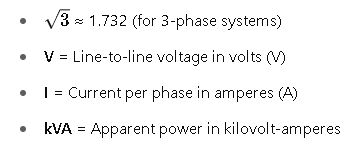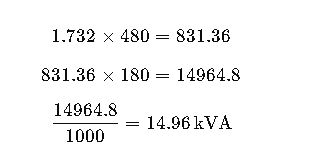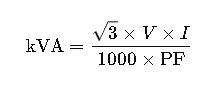Understanding volts to kVA conversion is vital for sizing, planning, and optimizing single or three-phase systems.
It ensures proper load distribution, prevents overload, and enhances power system efficiency in various applications.
Volts to kVA Calculator
Extensive Volts to kVA Conversion Tables
Below are practical tables showing the most common voltage levels and current values in industrial, commercial, and residential electrical systems. These tables assume a power factor of 1 (purely resistive loads) unless stated otherwise.
Table 1: Single-Phase Volts to kVA Conversion (Power Factor = 1)
| Voltage (V) | Current (A) | Apparent Power (kVA) |
|---|---|---|
| 120 | 10 | 1.20 |
| 120 | 50 | 6.00 |
| 240 | 10 | 2.40 |
| 240 | 50 | 12.00 |
| 240 | 100 | 24.00 |
| 277 | 10 | 2.77 |
| 277 | 50 | 13.85 |
| 480 | 10 | 4.80 |
| 480 | 100 | 48.00 |
| 600 | 50 | 30.00 |
| 600 | 100 | 60.00 |
Table 2: Three-Phase Volts to kVA Conversion (Line-to-Line Voltage, Power Factor = 1)
| Voltage (V) | Current (A) | Apparent Power (kVA) |
|---|---|---|
| 208 | 50 | 18.00 |
| 208 | 100 | 36.06 |
| 380 | 50 | 32.93 |
| 400 | 100 | 69.28 |
| 415 | 150 | 107.87 |
| 480 | 100 | 83.14 |
| 600 | 100 | 103.92 |
| 690 | 150 | 179.14 |
| 4160 | 200 | 1,441.00 |
| 13,800 | 300 | 7,174.80 |
Note: kVA values are rounded to two decimal places for simplicity. Use precision calculators for exact engineering values.
Volts to kVA Conversion Formulas Explained
1. Single-Phase Formula
Where:
- V = Voltage in volts (V)
- I = Current in amperes (A)
- kVA = Apparent power in kilovolt-amperes (kVA)
Common single-phase voltage levels: 120V, 240V, 277V, 480V
Example:
A single-phase device operates at 240V and draws 30A:
2. Three-Phase Formula (Line-to-Line Voltage)
Where:

Common 3-phase voltages: 208V, 400V, 415V, 480V, 600V, 4160V
Example:
A 3-phase motor operates at 480V drawing 75A per phase:
3. Three-Phase Formula (Line-to-Neutral Voltage)
Where:
- VLN= Line-to-neutral voltage (V)
- Other variables as previously defined.
Use this formula when neutral is accessible and you have L-N voltage.
Variable Range and Typical Values
| Variable | Description | Common Range | Notes |
|---|---|---|---|
| V | Voltage | 120V to 13.8kV | Depends on system: low, medium, or high voltage |
| I | Current | 1A to 1000A+ | Determined by load and breaker rating |
| Power Factor | Real vs. Apparent Power | 0.8 to 1.0 | Most kVA calculations assume PF = 1 |
| System Type | Single or Three Phase | Varies by region | US: 120/240, 277/480; EU: 230/400V |
Real-World Application Examples
Example 1: Sizing a Generator for a Commercial Building
Scenario:
A small commercial building uses a 3-phase 480V system with an estimated load of 180A.
Step-by-Step Calculation:
1.Use the 3-phase formula:
2.Multiply:
Answer:
The generator should be rated for at least 150 kVA to support this load with headroom.
Example 2: Electrical Transformer Load Planning
Scenario:
A residential neighborhood is supplied by a single-phase 240V transformer. The estimated max current draw is 100A.
Step-by-Step Calculation:
1.Use the single-phase formula:
2.Add contingency buffer:
- 20% safety margin:
Answer:
Select a 30 kVA transformer to accommodate future expansion and ensure safe operation.
Why Accurate Volts to kVA Conversion Matters
Applications
- Generator and UPS sizing
- Transformer load matching
- Electrical panel design
- Circuit breaker selection
- Data center infrastructure
- Industrial machinery planning
Consequences of Miscalculation
- Overloaded systems
- Equipment damage
- Inefficient operation
- Electrical code violations (e.g., NEC, IEC)
According to the National Electrical Code (NEC), accurate load calculation is critical to ensure the safety and performance of electrical systems.
Advanced Considerations: Power Factor and Its Impact
In real-world scenarios, the Power Factor (PF) is rarely 1. It’s a ratio of real power (kW) to apparent power (kVA), and it significantly affects calculations when converting volts to kVA.
Adjusted Formula Including Power Factor
Single-Phase:
Three-Phase:
Example with PF < 1
Scenario:
An industrial motor operates at 480V, draws 100A, and has a power factor of 0.85.
Three-phase calculation:
The same system would have shown only 83.14 kVA with PF = 1. This highlights the importance of correcting for power factor in planning.
Extended Volts to kVA Tables for Various Power Factors
Table 3: Three-Phase 480V System at Varying PF
| Current (A) | PF = 1.0 | PF = 0.95 | PF = 0.90 | PF = 0.85 |
|---|---|---|---|---|
| 10 | 8.31 | 8.75 | 9.23 | 9.78 |
| 25 | 20.78 | 21.94 | 23.08 | 24.46 |
| 50 | 41.57 | 43.87 | 46.30 | 48.91 |
| 75 | 62.35 | 65.81 | 69.45 | 73.37 |
| 100 | 83.14 | 87.75 | 92.61 | 97.82 |
| 200 | 166.28 | 175.51 | 185.23 | 195.63 |
| 300 | 249.42 | 263.26 | 277.84 | 293.45 |
These values are especially useful for motor control centers, HVAC systems, or facilities using variable frequency drives (VFDs).
Voltage Classes and Typical Applications
To effectively use the volts to kVA conversion, understanding voltage classes is essential.
| Voltage Class | Voltage Range | Application |
|---|---|---|
| Low Voltage (LV) | < 1,000V | Residential, light commercial |
| Medium Voltage (MV) | 1kV – 35kV | Distribution, industrial sites |
| High Voltage (HV) | 35kV – 230kV | Transmission substations |
| Extra High Voltage (EHV) | >230kV | Regional/national grid |
Compliance and Standards
Correct calculation of kVA based on voltage and current is not only an engineering best practice but also a regulatory requirement in many contexts.
Applicable Standards:
- NFPA 70 (NEC) – National Electrical Code (U.S.)
- IEC 60038 – IEC standard voltages (international)
- IEEE Std 141 (Red Book) – Electric power distribution
- NEMA MG 1 – Motors and Generators
- ISO 50001 – Energy management systems
For detailed electrical design, always consult the local code and IEC standards.
Tools and Online Resources
For engineers and technicians, using a calculator simplifies the process. Some reliable tools include:
Practical Tips for Engineers and Technicians
- Always check the power factor. If not provided, assume 0.8 for motors and 1.0 for resistive loads.
- Select equipment with headroom. Oversize transformers or generators by 15–20% for safety and future expansion.
- Consider inrush current. Especially with motors, the startup current is much higher than the running current.
- Use real-world tolerances. Voltage fluctuations can affect real power draw and transformer loading.
Frequently Asked Questions
What is the difference between kW and kVA?
- kW (kilowatts) = real power, what actually powers equipment.
- kVA (kilovolt-amperes) = apparent power, includes real and reactive power.
Why is three-phase power more efficient?
- Delivers more power with less conductor material.
- Ideal for heavy equipment and long distances.
- Three-phase systems are about 1.732 times more powerful than single-phase at the same voltage and current.
Can I convert volts to kVA without current?
- No. You need current (in amps) to calculate power.
- If only kW is known, use power factor to derive kVA:
Final Thoughts
Accurately converting volts to kVA is fundamental in modern electrical design. From selecting proper transformer sizes to ensuring generators meet facility demands, this conversion plays a critical role in energy management and system integrity. Incorporating power factor, load type, and system configuration ensures realistic, safe, and code-compliant calculations.












